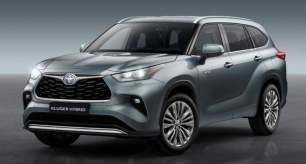The Patrol is a tried and tested 4WD, but it’s also an impressive open-road tourer.
The auto is a smooth shifter and when you give the throttle firm and steady right-foot pressure the Patrol rumbles up to speed with an almost-lazy efficacy.
Ride and handling are nicely controlled and composed, on sealed surfaces and that’s carried over onto dirt – which I’ll get to soon.
Its upright cabin stands tall, affording the driver ample visibility, and the Patrol’s expansive bonnet only impacts driver visibility when you head off-road – but more about that later.
The Patrol is refined and comfortable and yields a relaxed driving experience.
It has independent suspension – double wishbones and coil springs at every corner – as well as the Nissan’s 'Hydraulic Body Motion Control' system, a network of hydraulic cylinders cross-linked between wheels, which works like a swaybar/swaybar disconnect.
This system automatically alters tension to suit the terrain (tightens on-road to keep the Patrol more controlled on firmer surfaces, such as blacktop; loosens off-road allowing for more flex in the suspension when you’re 4WDing).
Let’s not forget the V8. There's nothing like that growl as a backing track to whatever trip you’re doing and you've always got that throaty engine note as your own personal theme music. Just to put a bit of pep in your step.
It really is a beast of a thing and it is fun to drive. You might pay the price with fuel bills if you enjoy tapping that accelerator with gusto, but, geez, it's worth it.
However, it’s when you get properly engaged in low-speed, low-range 4WDing that the Patrol is truly at home.
There’s no getting past the fact this Nissan wagon is a great touring platform and it’s also an impressive tow vehicle. There's no disputing those things, but it is a big vehicle and while it doesn’t feel as nimble as some other large SUV wagons, at least initially, it quickly becomes easier to drive the more time you spend in it.
It does take a little bit of getting used to if you haven't driven a Patrol before, but I have, many times, so it's quite comfortable and familiar to me.
Steering has a nice feel and weight to it when you’re doing low-range four-wheel driving – and it’s when low-speed, low-range four-wheel driving is when you really need precision and the ability to laser-focus your driving lines.
Throttle response is not touchy over bumps and sharp as long as you’re enthusiastic with it, and the auto transmission is just as cluey off-road as on. However, it can get caught out up hills, holding higher gears for too long, but otherwise it's okay.
There's an overall feeling of control to the Patrol. And again, while it is a large 4WD, it’s easy to drive well and to take on quite hardcore four-wheel driving terrain.
Drive with some consideration of its sheer physical dimensions and you’ll be fine. It’s comfortable and very capable; the result of a combination of traditional-style 4WD mechanicals, plenty of low-down torque and quietly effective driver-assist tech.
The Patrol Ti-L has selectable drive modes for off-road conditions and they include 'Snow', 'Sand' and 'Rock' and they tweak the traction control system, engine response and throttle with the aim of getting the Patrol to perform optimally on the chosen surface.
It has full-time 4WD with high- and low-range and, while it doesn't have the low-down torque of something like the 300 Series, it has plenty of grunt when it counts. There’s ample torque for smooth-momentum 4WDing and the big petrol V8 keeps things ticking along without any stress.
Beyond the very effective off-road traction control system and the great low- and mid-range torque, you also have a rear diff lock. So if things get that difficult, you can always engage it.
The Patrol has plenty of wheel travel, helped somewhat by its aforementioned swaybar-disconnect system, and that articulation helps it stretch a tyre to the dirt for all-important traction.
Off-road driver-assist tech (hill descent control, hill start assist etc) is non-intrusive and effective.
But it’s not all the best of news onboard the Patrol.
It feels quite low when you’re driving it over challenging terrain. Ground clearance is 273mm (compared to the 300 Series' 235mm) and approach, departure and rampover angles (28, 26.3, and 24.4 degrees) are par for the course for a large 4WD wagon with a wheelbase this lengthy.
But, while those measurements check out, that feeling of the Patrol being vulnerable to underbelly scrapes and knocks lingers.
Wading depth is listed as 700mm and, while I didn’t get the chance this time to test that limit (the usual mudholes were dry), I’ve driven through plenty of mudholes in this generation Patrol in the past.
As mentioned, the Patrol has an upright cabin, which offers plenty of visibility, but the expansive bonnet impacts the driver’s vision at the front, especially when driving over, for example, a steep crest into a dry creek bed.
As always, when faced with such a situation it’s best to get out of the vehicle and take a look.
The Patrol’s tyres – Bridgestone Dueler 693II all-terrains (265/70R18) – are perfectly reasonable on-road, but aren't well-suited to hardcore 4WDing.
As always with less-than-ideal off-roading rubber, if you're going to ask more of your Patrol than the occasional gentle drive along well-formed dirt tracks in dry weather, it's a good idea to replace the standard tyres with a decent set of aggressive all-terrain tyres.
I've tow-tested with many Patrol variants over the years, so it’s worthwhile noting the towing capacities which are 750kg (unbraked) and 3500kg (braked), so standard for this size of 4WD.











.png)
































.png)





























